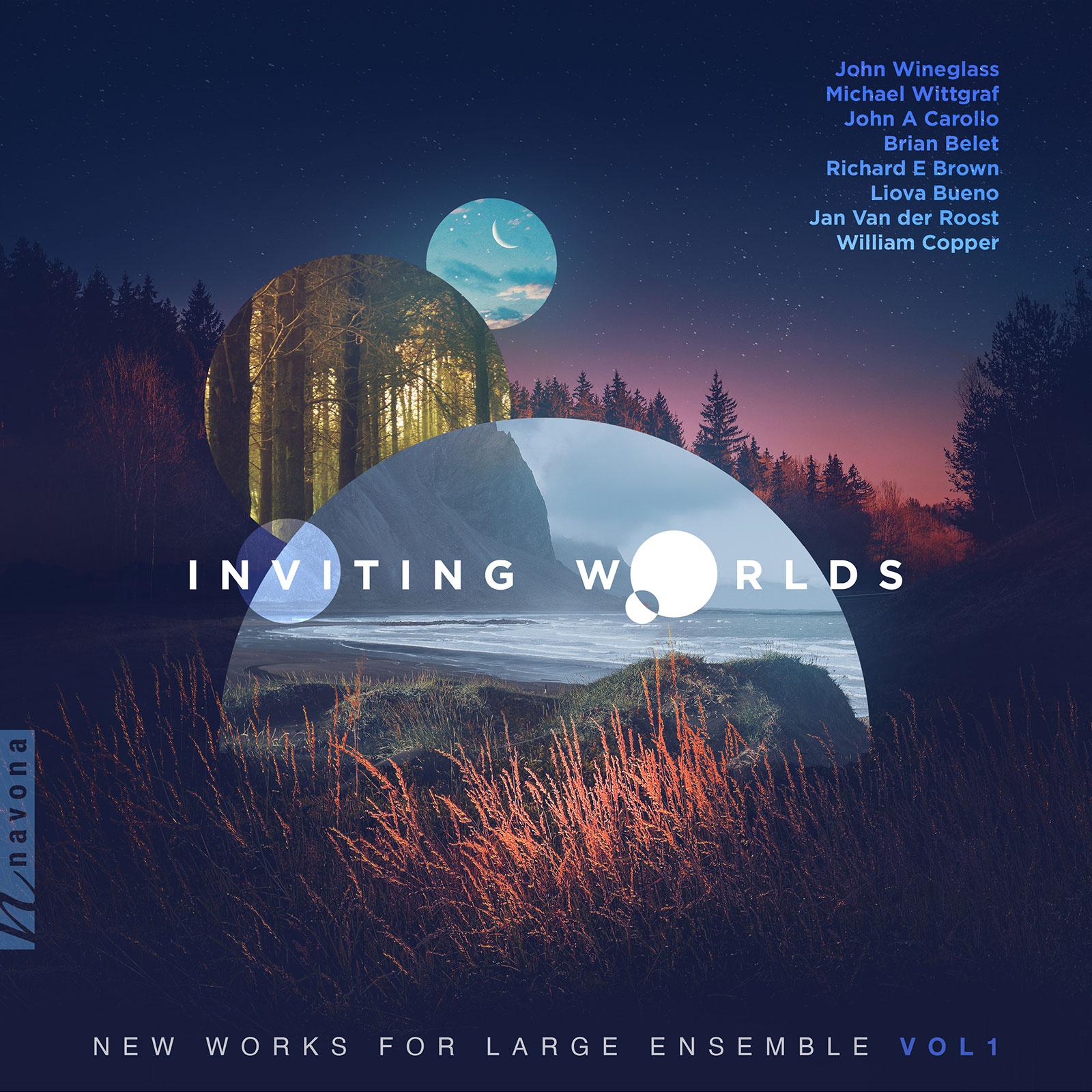Inviting Worlds
John Wineglass composer
Michael Wittgraf composer
John A. Carollo composer
Brian Belet composer
Richard E Brown composer
Liova Bueno composer
Jan Van der Roost composer
William Copper composer
From the mysterious magic of our darkest corners to the exuberant atmosphere of Carnaval, infinite possibilities lay within INVITING WORLDS from Navona Records. The musical dimensions of several composers are explored by the Janáček Philharmonic Ostrava, Zagreb Festival Orchestra, and the National Moravian-Silesian Theater Choir in this dynamic journey, offering insight into new realms through imaginative approaches to composition. Even in far away lands, close-to-home concepts are explored in thought-provoking soundscapes, showcasing the rhythmic dexterity and textural nuance of today’s orchestras across a wide breadth of compositional styles.
Listen
Stream/Buy
Choose your platform
Performance Video
John Wineglass – Bonny Doon
Track Listing & Credits
| # | Title | Composer | Performer | |
|---|---|---|---|---|
| 01 | Bonny Doon: From the Misty Redwoods Down to the Mighty Pacific Ocean | John Wineglass | Zagreb Festival Orchestra | Ivan Josip Skender, conductor | 5:46 |
| 02 | A Marriage of Seasons | Michael Wittgraf | Janáček Philharmonic Ostrava | Stanislav Vavrinek, conductor; | 10:23 |
| 03 | Dark Days | John A. Carollo | Janáček Philharmonic Ostrava | Jiří Petrdlík, conductor; National Moravian-Silesian Theatre Choir | 10:49 |
| 04 | Fantasia: Nocturne | Brian Belet | Janáček Philharmonic Ostrava | Jan Kučera, conductor; Jakub Černohorský, violin; Roman Buchal, flügelhorn | 11:02 |
| 05 | Expansions for Orchestra | Richard E Brown | Janáček Philharmonic Ostrava | Stanislav Vavrinek, conductor | 7:56 |
| 06 | Two Moods: Dusk & Carnaval: I. Dusk | Liova Bueno | Janáček Philharmonic Ostrava | Stanislav Vavrinek, conductor | 3:43 |
| 07 | Two Moods: Dusk & Carnaval: II. Carnaval | Liova Bueno | Janáček Philharmonic Ostrava | Stanislav Vavrinek, conductor | 4:05 |
| 08 | Céad Míle Fáilte | Jan Van der Roost | Janáček Philharmonic Ostrava | Stanislav Vavrinek, conductor; Eddy Vanoosthuyse, clarinet | 5:57 |
| 09 | This Full Bowl of Roses, Part I | William Copper | Janáček Philharmonic Ostrava | Jiří Petrdlík, conductor | 3:03 |
Bonny Doon: From the Misty Redwoods Down to the Mighty Pacific Ocean
Recorded September 8, 2021 at Vatroslav Lisinski Concert Hall Theatre in Zagreb, Croatia
Producer Krešimir Seletković
Engineer Pavel Kunčar
Assistant Engineer Jana Jelínková
Editing & Mixing Melanie Montgomery
A Marriage of Seasons, Expansions for Orchestra
Recorded May 24-25, 2021 at Dům Kultury města Ostravy (The Ostrava House of Culture) in Ostrava, Czech Republic
Producer Jan Košulič
Engineer Pavel Kunčar
Editing & Mixing Lucas Paquette
Two Moods: Dusk & Carnaval
Recorded May 27, 2021 at Dům Kultury města Ostravy (The Ostrava House of Culture) in Ostrava, Czech Republic
Producer Jan Košulič
Engineer Pavel Kunčar
Editing Jacob Steingart
Mixing Levi Brown
Additional Editing Lucas Paquette
Dark Days, This Full Bowl of Roses, Part I
Recorded November 18-19, 2021 at Dům Kultury města Ostravy (The Ostrava House of Culture) in Ostrava, Czech Republic
Producer Jan Košulič
Engineer Aleš Dvořák
Editing & Mixing Melanie Montgomery
Fantasia: Nocturne
Recorded December 7, 2021 at Dům Kultury města Ostravy (The Ostrava House of Culture) in Ostrava, Czech Republic
Producer Markéta Janáčková
Engineer Aleš Dvořák
Editing & Mixing Lucas Paquette
Céad Míle Fáilte
Recorded October 25, 2021 at Dům Kultury města Ostravy (The Ostrava House of Culture) in Ostrava, Czech Republic
Producer, Editing & Mixing Jan Košulič
Engineer Aleš Dvořák
Additional Editing Melanie Montgomery
Executive Producer Bob Lord
Executive A&R Sam Renshaw
A&R Director Brandon MacNeil
A&R Danielle Lewis, Quinton Blue, Chris Robinson, Jacob Smith
VP of Production Jan Košulič
Production Director Levi Brown
Audio Director Lucas Paquette
Production Manager Jean Noël Attard
Production Assistant Martina Watzková
Mastering Melanie Montgomery
VP, Design & Marketing Brett Picknell
Art Director Ryan Harrison
Design Edward A. Fleming, Morgan Hauber
Publicity Patrick Niland, Brett Iannucci
Content Manager Sara Warner
Artist Information
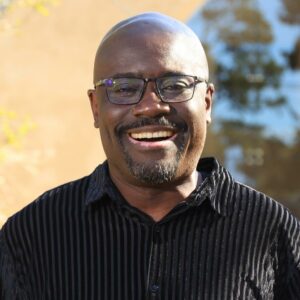
John Wineglass
John Christopher Wineglass is a multiple ®EMMY Award-Winning Composer who has performed on five continents, before U.S. presidents since Ronald Reagan, and with several ®OSCAR and ®GRAMMY Award-winning artists including Aretha Franklin, Whitney Houston, and Jamie Foxx to name a few. He has written several scores and incidental music for shows on MSNBC, CNN, NBC, CBS, and ABC as well as documentaries on Headliners & Legends for The Brady Bunch, Kathy Lee Gifford, and Farah Fawcett. Having scored mainly independent films, several of his nationally syndicated commercials include music for the United States Army, American Red Cross, and Texaco as well.

Michael Wittgraf
Michael Wittgraf (b. 1962) is an electronic music composer whose recent work explores live manipulation of feedback, interactive improvisation, and video. His music has been performed around the world, and is available on the Ravello, New Ariel, Eroica, and SEAMUS recording labels, and through iTunes, Spotify, SoundCloud, YouTube, and other platforms. He has awards, commissions, and recognition from ASCAP, Modern Chamber Players, National Symphony Orchestra, Tempus Fugit, Louisiana State University, University of Minnesota, University of North Dakota, Florida State University, PiKappa Lambda, Zeitgeist, Chiara String Quartet, Bush Foundation, North Dakota Museum of Art, North Dakota Council on the Arts, and more. He was awarded a North Dakota Individual Artist Fellowship in 2007, and in 2011 he was named the North Valley Arts Council Artist of the Year.
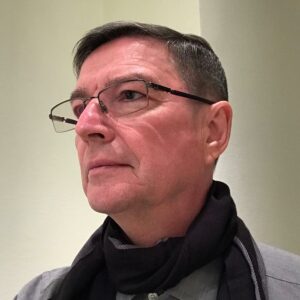
John A. Carollo
John A. Carollo was born in Torino, Italy and brought to the United States by his adoptive parents. When he was in grade school, he studied classical piano and sang in the church choir. While attending college in San Diego CA, he studied music and psychology. During this time, Carollo took piano lessons and began composing his first piano works. He graduated from San Diego State University being granted a master’s degree in clinical psychology.
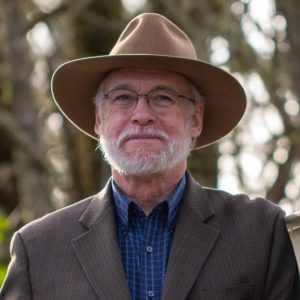
Brian Belet
Brian Belet lives in northwestern Oregon with his partner and wife Marianne Bickett. His album SUFFICIENT TROUBLE, containing ten of his computer music compositions, was published by Ravello Records in 2017. Stellar Nebulae, for string orchestra, was published on the album PRISMA VOL. 4 by Navona Records in 2020, and his brass quintet Three by Five was published on the album BRASS TACKS, also by Navona Records, in 2022. Additional music is recorded on albums published by Capstone, Centaur, Frog Peak Music, IMG Media, Innova, New Ariel Recording, SWR Music/Hänssler Classic, and the University of Illinois labels, with research published in Contemporary Music Review, Organised Sound, Perspectives of New Music, Proceedings of the International Computer Music Conference, and Proceedings of the International Web Audio Conference.
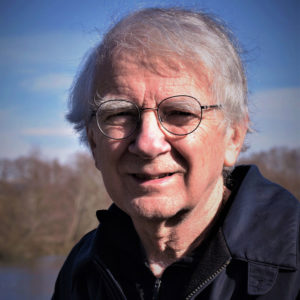
Richard E Brown
Richard E. Brown, a native of New York State and has been active as a composer-arranger and music educator for many years. His training includes M.M. and D.M. degrees in composition from Florida State University, as well as a B.A. in music education from Central College, which named him a Distinguished Alumnus in 1983. His principal composition studies were with Carlisle Floyd, John Boda, and Charles Carter. He is a member of ASCAP and is represented in the catalogs of several trade publishers, as well as his personal imprint Dacker Music.
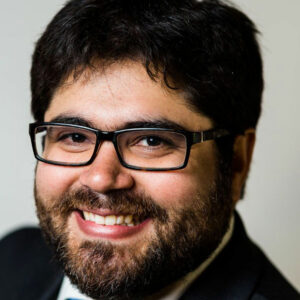
Liova Bueno
Liova Bueno's music is performed in concerts and music festivals internationally, from Europe, the United States, and across Canada to countries in Central and South America. He has received commissions from and has collaborated with various ensembles, including Cuarteto de Bellas Artes (Mexico), Vox Humana Chamber Choir (Victoria, B.C.), the Victoria Choral Society (Victoria, B.C.), the London Symphony Orchestra (U.K.), the Janáček Philharmonic Orchestra (Czech Republic), BRNO Contemporary Orchestra (Czech Republic), the Illinois Modern Ensemble (Illinois), the Orquesta Sinfónica Nacional Juvenil and members of the Orquesta Sinfonica Nacional (Dominican Republic), and members of the Victoria Symphony.

Jan Van der Roost
Jan Van der Roost was born in Duffel, Belgium in 1956. He studied at the Lemmensinstituut and at the Royal Conservatories of Ghent and Antwerp, where he qualified as a conductor and a composer. Besides being a prolific composer, he also is very much in demand as an adjudicator, lecturer, clinician, and guest conductor: his musical activities took him to over 50 countries while his compositions have been performed/recorded around the world.
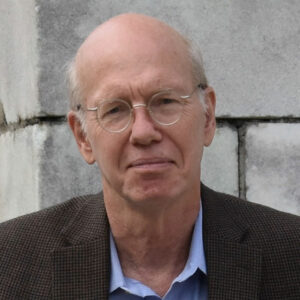
William Copper
William Copper is an American composer of contemporary classical music, a theorist, and the authority on Intonalism, the science of structuring music according to intonation. His music is praised for its beauty, structural integrity, and innovative originality. He has been a life-long supporter and volunteer as Board Member and officer for music and cultural organizations.

Zagreb Festival Orchestra
The Zagreb Festival Orchestra was founded in 1989, comprised of the top classical performers in Croatia and formed with the intent to record a single album. That intent was fulfilled with OVERTURES, a record of composer Gioachino Rossini’s greatest operatic works conducted by the acclaimed maestro Michael Halász, a resident conductor at the Vienna State Opera for 20 years, and produced by six-time GRAMMY Award winner Martin Sauer.
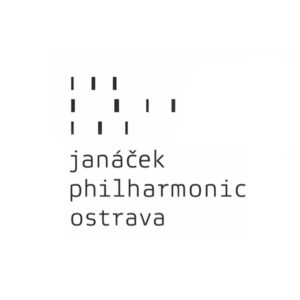
Janáček Philharmonic Ostrava
The Janáček Philharmonic is a world-class symphony orchestra based in Ostrava, Czech Republic and an emerging figure on the international performance scene. With over 100 top-level musicians, the orchestra aims to introduce unique, quality repertoire while showcasing their own recognizable sound.
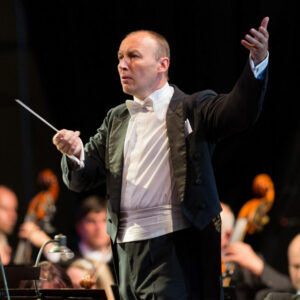
Stanislav Vavřínek
Stanislav Vavřínek is one of the most prominent Czech conductors and has been Chief Conductor of the Czech Chamber Philharmonic Orchestra Pardubice since 2018. Having graduated from the Conservatory in Brno where he studied flute and conducting, he continued his education at the Academy of Performing Arts in Prague. Subsequently, he also took master classes with Roberto Benzi in Switzerland, culminating with a concert in which he conducted the Biel Philharmonic Orchestra.
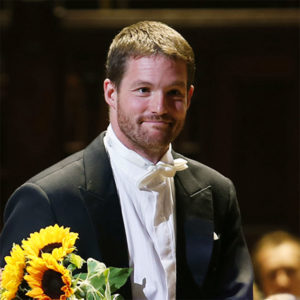
Jiří Petrdlík
Jiří Petrdlík (b. 1977) is appreciated as one of the most respectable conductors of his generation. He studied piano, trombone, and conducting — 1995–2000 at Prague Conservatory, and 2000–2005 at Academy of Performing Arts Prague — with Hynek Farkač, Miroslav Košler, Miriam Němcová, Radomil Eliška, and Tomáš Koutník, and took part in the masterclasses of the New York Philharmonic Principal Conductor Kurt Masur and the BBC Philharmonic Principal Conductor Jiří Bělohlávek. Petrdlík also successfully took part in several competitions, including the Donatella Flick Conductor Competition in London.
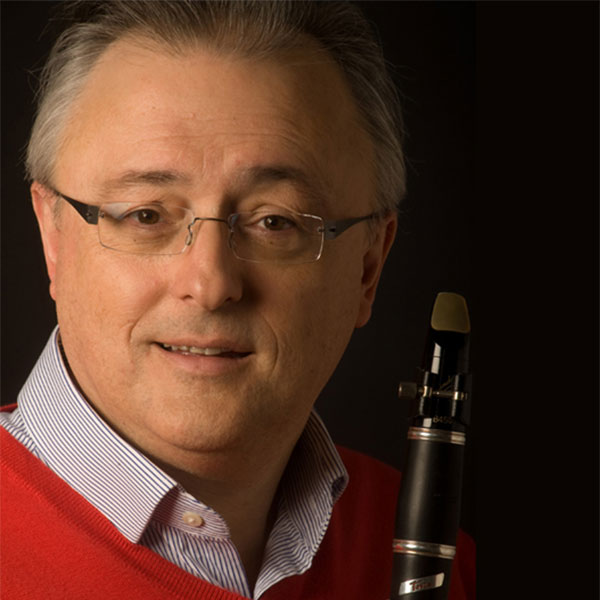
Eddy Vanoosthuyse
Eddy Vanoosthuyse is the clarinet professor of the Royal Conservatory of Ghent/Belgium and the Fontys Conservatory of Tilburg/Holland. He is the artistic director of the “International Clarinet Competition Ghent,” and the former principal clarinet of the Brussels Philharmonic. He was selected for the World Philharmonic (Georges Prêtre) and invited for the Symphonicum Europae.
